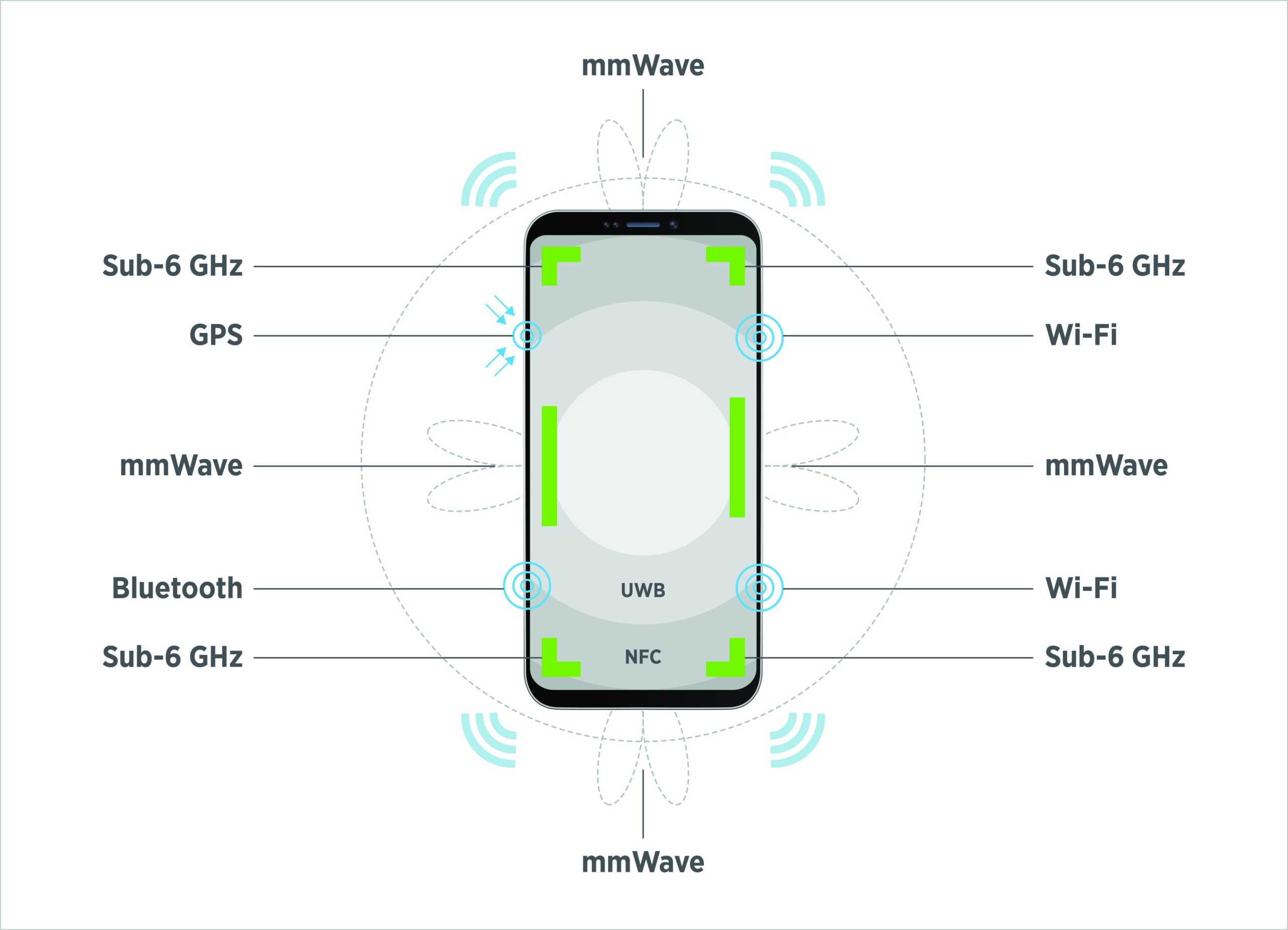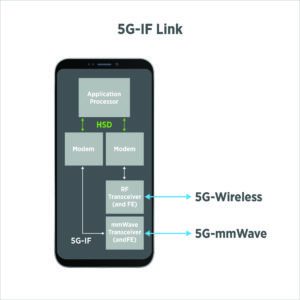A Quick Wireless History – How We Got to 5G
Every decade brings with it a plethora of technology changes, and the cumulative effects of 50+ years of changes in wireless technologies are noteworthy for how they have changed the way we communicate.
- The 80’s began the era of personal computing along with 1G rollout
- The 90’s saw the advent of 64-bit microprocessor architecture in consumer devices coinciding with 2G rollout
- The 2000’s saw the first iPhone and the rollout of 3G
- The 2010’s is when 64-bit architectures emerged in smartphones along with the 4G rollout and the beginning of digital transformation strategies
- The 2020’s begins a computing renaissance along with the 5G rollout during a global pandemic, including the deployment of mmWave technology
- The 2030’s is likely the beginning of the 6G rollout
With a global population of 8 billion, it’s remarkable that the semiconductor industry currently produces approximately 1.5 billion smartphones every year, and the global supply chain continues to evolve at a cadence that is truly impressive. As this evolution suggests, the main underlying enabler for change lies in the convergence of digital and wireless technologies working seamlessly together to achieve a greater common benefit: information access anytime, anywhere.
Overview of the Unique Features of 5G
The global 5G NR (New Radio) rollout is well underway and, compared to 4G, will deliver significantly faster and more responsive mobile experiences. The migration to 5G includes a new radio access technology (RAT) that uses new frequency range designations:
- FR1 occupies 410 MHz – 7125 MHz
- FR2-1 occupies 24.25 GHz – 52.6 GHz (Release 15)
- FR2-2 occupies 52.6 GHz to 71 GHz (Release 17)
Yes, for the first time ever, 5G is synonymous with the deployment of mmWave technology. The motivation for mmWave is delivery of the next generation user experience (over traditional cellular networks). These experiences include 1 Gbps downloads in places where large populations have had degraded mobile experiences. For example, many venues, including stadiums, will deploy mmWave to create more immersive experiences. Also, dense urban areas like transportation hubs (airports) will have more responsive connections. Over the horizon, we’re likely to see deployments in fixed wireless access (last mile), indoor enterprises (private networks), and other industrial IoT applications. What’s common to all is faster and more responsive mobile experiences in denser environments.
The combination of higher frequencies and greater bandwidth is what leads to extreme data rates. For reference, a 6 GHz signal wavelength (in FR1) is on the order of 50 mm. At 39 GHz (in FR2-1), the wavelength shrinks to 7.7 mm. Next at 60 GHz, the wavelength is only 5.0 mm (1/10th the wavelength in FR1). As these figures reveal, mmWave transmit and receive technologies are possible with more compact antennas that can fit just about anywhere.
Not all 5G smartphones have mmWave links yet. The 5G rollout has an economy class that offers all the benefits of 5G except for mmWave. This economy class offers coverage for FR1 only. In contrast, today’s flagship 5G smartphones offer coverage for both FR1 and FR2-1. In this modular approach, the FR1 capabilities are the foundation on which both economy and premium class 5G smartphones will ship going forward. The final mix of economy and premium phones depends on the future adoption of mmWave technology, but all major flagship smartphones today offer mmWave support. Therefore, these unique wireless features are already shipping in a subset of today’s handsets as mmWave adoption proliferates.
What are the enablers for these unique wireless features? Although this is not an exhaustive list, the key 5G enablers for this wireless transformation are massive multiple input, multiple output (MIMO) and evolved beamforming capabilities. Taming these wireless complexities throughout the semiconductor ecosystem is a task of epic proportions.
Antenna, MIMO, Beamforming, and 5G-IF
 Besides large bandwidth availability in the mmWave spectrum, antennas in these wavelengths are much smaller relative to FR1, such that packaging a large number into a small area is now possible for increasing gain and achieving beamforming. In effect, MIMO enables link connections (and improves quality) by effectively steering mmWave signals between a smart phone and base stations. And, if that wasn’t enough complexity, MIMO also enables multiple users to share the same resources simultaneously (MU-MIMO).
Besides large bandwidth availability in the mmWave spectrum, antennas in these wavelengths are much smaller relative to FR1, such that packaging a large number into a small area is now possible for increasing gain and achieving beamforming. In effect, MIMO enables link connections (and improves quality) by effectively steering mmWave signals between a smart phone and base stations. And, if that wasn’t enough complexity, MIMO also enables multiple users to share the same resources simultaneously (MU-MIMO).
Inside a 5G smartphone, these MIMO antenna structures are deployed around the perimeter to facilitate best line of site (LOS) connections to the network. The signal distribution continues with connections between these antenna structures and the modem via an intermediate frequency (5G-IF) mechanism. In this way, a complete antenna to bits connection is available for transmit and receive operations within the 5G smartphone – an engineering marvel when we consider how all these technologies seamlessly work together to create faster and more responsive connections.
Financial Implications of 5G
Standards scope the 5G complexities but that’s only half the solution. The other half that brings this innovation to life involves the commercialization process. Inside a 5G smartphone, the bill of material (BOM) will require two new items to support the mmWave linkage:
- Antenna in package (AiP) devices that support mmWave linkages (x3 per smartphone)
- Modem capabilities that expand to support the 5G-IF linkage to AiP devices
These additions represent an additive cost because the prior generation smartphone architecture did not include them. Furthermore, the commercialization effort includes the development and deployment of a mmWave supply chain capable of high-volume unit shipments.
The commercialization process must also tame the financial hurdles in bringing this new technology to market. The risk is if it’s priced too high then adoption will slow. On the upside, the potential for extracting premiums for new services and increasing return on investment will also affect pricing strategies. Thus, suppliers of mmWave technology must find a balance that will benefit the entire semiconductor ecosystem, including the investment community and the consumers that ultimately purchase the end product.
AiP Device, Packaging Antenna with RFIC
Built for beamforming in consumer products, the AiP device is a fully integrated module, containing power amplifiers, low-noise-amplifiers, switches, transceivers, filters, and a discrete antenna. In summary, the AiP device provides an RF front end (RFFE) function at mmWave for use by the 5G architecture. The package is generally considered a type of system in package (SiP), which implies it encompasses heterogeneous integration as well. Indeed, the AiP device is an engineering marvel especially in the context of advanced packaging technology. And commercialization requires new methods for assembly and test, which is evolving to include over the air (OTA) methodologies.
5G-IF Signal Distribution Mechanism

At the core of the 5G smartphone is the transceiver and modem functions that convert RF to bits. With the addition of mmWave, this core functionality must evolve to handle the signal distribution linkage to the AiP device. The signal distribution is usually in the 10-20 GHz range and has implications for test, specifically it is a more expensive test coverage than FR1 only.
The Economic Challenge of 5G
All this engineering complexity comes at a financial cost that also needs to be tamed in relation to test. Reducing test duration and negotiating with suppliers on the bill of materials is not a sufficient strategy, especially in this era. Instead, a roadmap and migration to higher site densities is the proven path in the relentless pursuit of cost reductions. That said, a bit of a renaissance is also underway in test, coinciding with the 5G rollout, and that’s the doubling of site counts for the RF devices tested through the ecosystem. Not just devices for FR1, but also for FR2-1, FR2-2, and beyond. Just like the devices, the test and measurement industry is evolving to keep pace with the emerging complexity, both in terms of innovation and economics.
For reference, Teradyne is a proud pioneer of today’s standard in RF transceiver test, which is built around x8 sites. In addition, Teradyne continues to push forward with our trailblazing efforts, a frontier that includes a solution for commercializing emerging mmWave technology. At the time of this writing, we are beginning our rollout of x16 site density, the new standard in RF and mmWave transceiver test on the UltraFLEXplus. And for the emerging AiP devices, we take great pride in our achievement of x8 site density, the new standard in parallel OTA test.
What’s Next? A Peek into the 6G Rollout
As this blog suggests, peel away the surface of most technology shifts and there is a level of multi-discipline complexity that requires a deliberate and cohesive engineering effort to tame. As a result of our collaboration with fellow market-leading pioneers, Teradyne has evolved over the decades to become a valuable partner in bringing wireless innovation to life, including mmWave technology: Teradyne tames complexity.
As we look ahead to 6G, we continue to push forward, next setting our sights (forgive the pun) on the relentless pursuit of test cost reductions throughout the wireless ecosystem. Trailblazing is woven into our culture and pioneering innovative solutions for emerging technologies is how we measure our success. The test technology to enable the future is under development now, along with the mechanisms for commercialization. The realization of the next generation is paved not only with great technology, but with the tools and a proven team to ramp up volume to satisfy the needs of a global economy.
Learn more about Teradyne’s UltraFLEXplus tester and our mmWave instrumentation, and contact us to collaborate on the future of wireless.

David Vondran is the wireless product manager at Teradyne, promoting ATE solutions for high volume manufacturing, including those for mmWave applications. He has held engineering and marketing positions at Rockwell International, Watkins-Johnson, Pacific Monolithics, California Microwave, Anritsu, OML, LitePoint, Advantest, and Astronics Test Systems. David holds a B.S. degree in electrical engineering from California State Polytechnic University, Pomona.